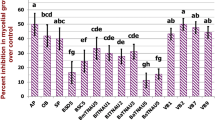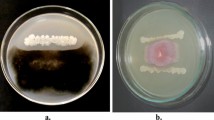Abstract
We attempted to study the antibacterial activity of rhizospheric Bacillus spp., to curb the bacterial blight of anthurium caused by Xanthomonas axonopodis pv. dieffenbachiae (Xad). Twenty-eight bacterial isolates from rhizospheric regions were identified as different Bacillus spp. and Ochrobactrum sp. using 16S rRNA gene sequencing. B. subtilis BIO3 effectively inhibited the growth of Xad up to 1450.7 mm2, and extracted volatile organic metabolites from the isolate BIO3 inhibited the growth of Xad up to 1024 mm2. Tritrophic interaction of anthurium leaves bacterized with B. subtilis BIO3 and challenged with Xad resulted in the expression of 12 unique proteins compared to untreated control. Mascot Peptide Mass Fingerprint-based identification indicated that one was glutathione peroxidase, involved in defence mechanism, other six proteins were identified as leghemoglobin II, CTP synthase-like, predicted protein (Physcomitrella patens), centromere-associated protein E, grain size protein, and five proteins were hypothetical proteins. Foliar application with 1% liquid formulations (108 CFU/ml) of B. subtilis BIO3 significantly suppressed the bacterial leaf blight of anthurium up to 78% over untreated control and also increased the stem length and flower yield.







Similar content being viewed by others
References
Athukorala SNP, Fernando WGD, Rashid KY (2009) Identification of antifungal antibiotics of Bacillus species isolated from different microhabitats using polymerase chain reaction and MALDI-TOF mass spectrometry. Can J Microbiol 55:1021–1032
Aysan Y, Sahin F (2003) First report of bacterial blight of anthurium caused by Xanthomonas axonopodis pv. dieffenbachiae in Turkey. New Dis Rep 7:5
Balan S, Sajeesh PK, Abraham K (2014) Morphological and biochemical characterization of Xanthomonas axonopodis pv. dieffenbachiae (McCulloch & Pirone) causing bacterial blight of anthurium (Schott.). Trends in Biosciences 7(8):636–640
Bauer AW, Kirby WM, Sherris JC, Turck M (1966) Antibiotic susceptibility testing by a standardized Single disk method. Am J Clin Pathol 45:493–496
Blum H, Beier H, Gross HJ (1987) Improved silver staining of plant proteins, RNA and DNA in polyacrylamide gels. Electrophoresis 8:93–99
Cano RJ, Borucki MK, Highby-Schweitzer M, Poinar HN, Poinar GO, Pollard KJ (1994) Bacillus DNA in fossil bees: an ancient symbiosis. Appl Environ Microbiol 60(6):2164–2167
Cheng J, Jaiswal KS, Yang SH, Suh JW (2016) Endophytic Bacillus subtilis MJMP2 from Kimchi inhibits Xanthomonas oryzae pv. oryzae, the pathogen of rice bacterial blight disease. J Appl Biol Chem 59(2):149–154
Das R, Mondal B, Mondal P, Khatua DC, Mukherjee N (2014) Biological management of citrus canker on acid lime through Bacillus subtilis (S-12) in West Bengal, India. J Biopest 7:38–41
Dhanya S, Sreekumar J, Jisha MS (2016) Evaluation of antagonistic potential and induction of flowering in Anthurium andreanum L. by indigenous Pseudomonas taiwanensis. Int J Agric Innov Res 4(4):760–766
Dheepa R, Vinodkumar S, Renukadevi P, Nakkeeran S (2016) Phenotypic and molecular characterization of chrysanthemum white rust pathogen Puccinia horiana (Henn) and the effect of liquid based formulation of Bacillus spp. for the management of chrysanthemum white rust under protected cultivation. Biol Control. https://doi.org/10.1016/j.biocontrol.2016.09.006
Gomez KA, Gomez AA (1984) Statistical procedure for agricultural research. Wiley, New York
Isabel M, Jordi C, Emilio M (2011) Antimicrobial peptide genes in Bacillus strains from plant environments. Int Microbiol 14:213–223
Knapp JE, Chandlee JM (1996) RNA/DNA mini-prep from a single sample of orchid tissue. Biotechniques 21:54–56
Kumsingkaew S, Akarapisan A (2014) Efficiency of Bacillus subtilis EPB14 as Biocontrol to control bacterial leaf blight of anthurium. Int J Agric Technol 10(3):755–766
Larkin MA, Blackshields G, Brown NP, Chenna R, McGettigan PA, McWilliam H, Valentin F, Wallace IM, Wilm A, Lopez R, Thompson JD, Gibson TJ, Higgins DG (2007) Clustal W and Clustal X version 2.0. Bioinformatics 23(21):2947–2948
Li SB, Fang M, Zhou RC, Huang J (2012) Characterization and evaluation of the endophyte Bacillus B014 as a potential biocontrol agent for the control of Xanthomonas axonopodis pv. dieffenbachiae-Induced blight of Anthurium. Biol Control 63(1):9–16
Li SB, Xu SR, Zhang RN, Liu Y, Zhou RC (2015) The antibiosis action and rice induced resistance, mediated by a lipopeptide from Bacillus amyloliquefaciens B014, in controlling rice disease caused by Xanthomonas oryzae pv. oryzae. J Microbiol Biotechnol 26(4):748–756. https://doi.org/10.4014/jmb.1510.10072
Lian L, Xie L, Zheng L, Lin Q (2011) Induction of systemic resistance in tobacco against Tobacco mosaic virus by Bacillus spp. Biocontrol Sci Technol 21:281–292
Mohan Kumar SP, Chowdappa P, Krishna V (2015) Development of seed coating formulation using consortium of Bacillus subtilis OTPB1 and Trichoderma harzianum OTPB3 for plant growth promotion and induction of systemic resistance in field and horticultural crops. Indian Phytopath 68(1):25–31
Nadia MH, Hajri A, Boureau T, Darrasse A, Durand K, Brin C, Fischer-LeSaux M, Manceau C, Poussier S, Pruvost O, Lemaire C, Marie-Agnes J (2013) Evolutionary history of the plant pathogenic bacterium Xanthomonas axonopodis. PLoS ONE 8(3):e58474
Nakkeeran S, Surya T, Vinodkumar S (2019) Antifungal potential of plant growth promoting Bacillus species against blossom blight of rose. J Plant Growth Regul. https://doi.org/10.1007/s00344-019-09966-1
Nishijima WT (1988) Anthurium blight: An overview. In: A. M. Alvarez (Eds) Proceedings of the first anthurium blight conference, Honolulu, USA, pp. 6–8
Prabhukarthikeyan SR, Manikandan R, Durgadevi D, Keerthana U, Harish S, Karthikeyan G, Raguchander T (2017) Bio-suppression of turmeric rhizome rot disease and understanding the molecular basis of tripartite interaction among Curcuma longa, Pythium aphanidermatum and Pseudomonas fluorescens. Biol Control 111:23–31
Prakasha DP, Ramya G, Srinivasalu GB (2017) Morphogenetic responses in Anthurium andreanum (Hort) cultivars. Curr Agric Res J 5(1):135–140
Prapagdee B, Tharasaithong L, Nanthaphot R, Paisitwiroj C (2012) Efficacy of crude extract of antifungal compounds produced from Bacillus subtilis on prevention of anthracnose disease in Dendrobium Orchid. Environ Asia 5(1):32–38
Rajamanickam S, Karthikeyan G, Kavino M, Manoranjitham SK (2018) Biohardening of micro-propagated banana using endophytic bacteria induces plant growth promotion and restrain the rhizome rot disease caused by Pectobacterium carotovorum subsp. carotovorum. Sci Hortic 231:179–187
Sathyanarayana N, Reddy OR, Latha S, Rajak RL (1998) Interception of Xanthomonas campestris pv Dieffenbachiae on Anthurium plants from the Netherlands. Plant Dis 82(2):262
Saveetha K, Karthiba L, Raveendran M, Saravanakumar D, Suresh S, Raguchander T, Balasubramanian P, Samiyappan R (2009) Understanding the molecular basis of plant growth promotional effect of Pseudomonas fluorescens on rice through protein profiling. Proteome Sci 7:1–8
Shen S, Jing Y, Kuang T (2003) Proteomics approach to identify wound response related proteins from rice leaf sheath. Proteomics 3:527–535
Shevchenko A, Wilm M, Vorm O, Mann M (1996) Mass spectrometric sequencing of proteins silver-stained polyacrylamide gels. Anal Chem 68:850–858
Shrestha BK, Karki HS, Groth DE, Nootjarin JN, Ham JH (2016) Biological control activities of rice-associated Bacillus sp. strains against sheath blight and bacterial panicle blight of rice. PLoS ONE 1(1):e0146764
Srinivasan K, Mathivanan N (2011) Plant growth promoting microbial consortia mediated classical biocontrol of sunflower necrosis virus disease. J Biopest 4(1):65–72
Suganyadevi M, Nakkeeran S, Renukadevi P (2015) Molecular characterization of plant quarantine pathogen Xanthomonas axonopodis pv dieffenbachiae causing bacterial blight in anthurium and its management. J Mycol Plant Pathol 45(4):336–341
Teixeira da Silva JA, Dobranszki J, Winarto B, Zeng S (2015) Anthurium in vitro: a review. Sci Hortic 186:266–298
Vinodkumar S, Nakkeeran S, Renukadevi P, Malathi VG (2017) Biocontrol potentials of antimicrobial peptide producing Bacillus species: multifaceted antagonists for the management of stem rot of carnation caused by Sclerotinia sclerotiorum. Front Microbiol 8:1–13
Weisburg WG, Barns SM, Pelletier DA, Lane DJ (1991) 16S ribosomal DNA amplification for phylogenetic study. J Bacteriol 173(2):697–703
Suganyadevi M, Renukadevi P, Nakkeeran S (2016) Efficacy of biocontrol agents and bactericides for the management of bacterial blight incited by Xanthomonas axonopodis pv. dieffenbachiae in Anthurium andraeanum. Int J Plant Protect 9(1):292–296
Acknowledgement
The author acknowledges DST-FIST, Department of Science and Technology, Government of India, New Delhi, for the infrastructure facilities for conducting the experiments.
Author information
Authors and Affiliations
Contributions
NS and RS have performed the laboratory experiments, glasshouse experiment, statistical analysis, data recording and writing the original draft. SM has performed the proteomic study. All authors proofread and reviewed the manuscript.
Corresponding author
Ethics declarations
Conflict of interest
On behalf of all authors, the corresponding author states that there is no conflict of interest.
Human and animal rights
This article does not contain any studies with human participants or animals performed by any of the authors.
Informed consent
Informed consent was obtained from all individual participants included in the study.
Electronic supplementary material
Below is the link to the electronic supplementary material.
Rights and permissions
About this article
Cite this article
Nakkeeran, S., Suganyadevi, M. & Rajamanickam, S. Understanding the molecular basis on the biological suppression of bacterial leaf blight of anthurium exerted by Bacillus subtilis (BIO3) through proteomic approach. 3 Biotech 10, 468 (2020). https://doi.org/10.1007/s13205-020-02456-2
Received:
Accepted:
Published:
DOI: https://doi.org/10.1007/s13205-020-02456-2




